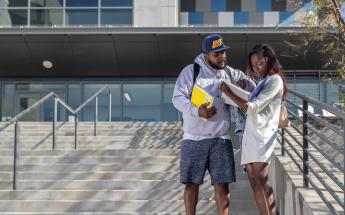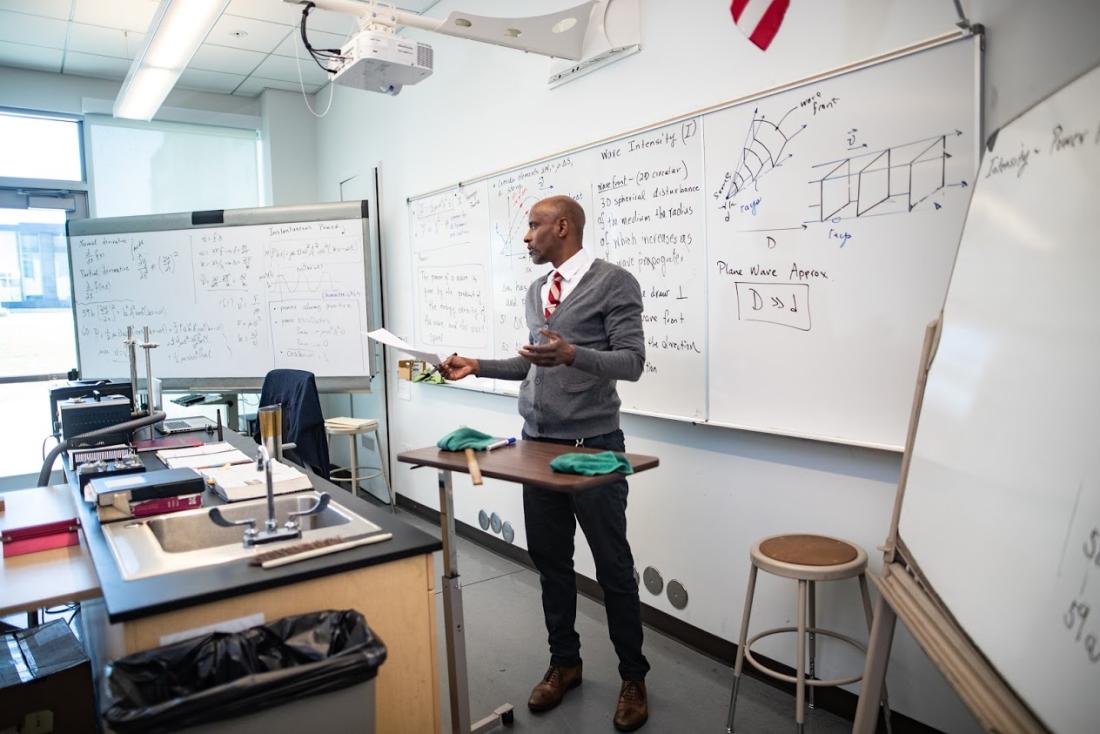Physics (AST)
Careers in Physics
After receiving their bachelor’s degree, most physicists work in the private sector in STEM-related occupations, while some work in the military, or go on to earn graduate degrees in physics or astronomy.
Here are some careers and their salaries you could have with a physics degree:
Career information below taken from bls.gov November 2019. Go to bls.gov for most current career information.
Design, develop, build, and test mechanical and thermal sensors and devices.
National data
| Typical Education Level: | Salary: | Hourly Median Wage: |
| Bachelor’s Degree | $87,370/year | $42.00/hour |
| Work Experience in a Related Occupation: | Job Outlook 2018-2028: | Number of Jobs 2018: |
| None needed | 4% increase (as fast as average) |
312,900 |
Aid criminal investigations by collecting and analyzing evidence.
National data
| Typical Education Level: | Salary: | Hourly Median Wage: |
| Bachelor’s Degree | $58,230/year | $27.99/hour |
| Work Experience in a Related Occupation: | Job Outlook 2018-2028: | Number of Jobs 2018: |
| Moderate-term on-the-job training | 14% increase(much faster than average) |
16,700 |
Represent clients in proceedings with the U.S. Patent and Trademark Office to smooth out the patent examination process to ensure that there is a legal and scientific rationale for an applicant’s claims.
National data
| Typical Education Level: | Salary: | Hourly Median Wage: |
| Bachelor’s Degree | $115,400/year | N/A |
| Work Experience in a Related Occupation: | Job Outlook 2018-2028: | Number of Jobs 2018: |
| Less than 5 years | N/A |
9,400 |
Research and study the structures and chemical properties of various natural and synthetic or composite materials, including metals, alloys, rubber, ceramics, semiconductors, polymers, and glass. Determine ways to strengthen or combine materials or develop new materials with new or specific properties for use in a variety of products and applications. Includes glass scientists, ceramic scientists, metallurgical scientists, and polymer scientists.
Data for Los Angeles/Long Beach/Anaheim
| Typical Education Level: | Salary: | Hourly Median Wage: |
| Bachelor’s Degree | $91,830/year | $44.15/hour |
| Work Experience in a Related Occupation: | Job Outlook 2018-2028: | Number of Jobs 2018: |
| None needed | 4% increase (as fast as average) | 440 |
Study the ways in which various forms of matter and energy interact.
Data for Los Angeles/Long Beach/Anaheim
| Typical Education Level: | Salary: | Hourly Median Wage: |
| Doctoral or Professional Degree | $119,580/year |
$57.49/hour |
| Work Experience in a Related Occupation: | Job Outlook 2018-2028: | Number of Jobs 2018: |
| None needed | 9% increase (faster than average) |
21,600 |
What You’ll Learn at LASC in Physics
You can get an Associate in Science for Transfer (AST) or an Associate in Science (AS) degree through LASC’s Physics program where you will develop your foundation in understanding the basic principles of physics, how to problem-solve logically and scientifically:
- Hone your critical-thinking, logical, and analytical skills and develop your curiosity for how things work and how to find solutions to everyday problems.
- Solve mechanical and electrical problems related to the motion of electromagnetism, dynamics, Newton’s laws, and others.
- Learn about the uses of physics in areas such as medicine, dentistry, architecture, and others where it has improved our lives and made society safer.
- LASC provides internships so you can build your career connections and create community ties for after you graduate.
- To transfer with your Associate in Science for Transfer (AST) degree in Physics, you will save money on your first two years of college learning from passionate, innovative faculty. And, when you successfully complete your AST, you can graduate with guaranteed admission into a CSU, and even some UCs! Talk with your academic counselor for details.
Degrees & Courses You Will Take
Review LASC’s Associate in Science for Transfer (AST) and Associate in Science (AS) degrees in Physics, and our suggested course of study for these programs. Go to LASC’s current Course Catalog for specific course information:
Major Code: 1902.00
Total Units Required: 60
The intent of the Associate in Science in Physics for Transfer Degree is to help you in seamlessly transferring to a CSU or possibly a UC.
If you are interested in completing an Associate Degree for Transfer, you must:
- Complete 60 semester units of 90-quarter units that are eligible for transfer to the California State University, including both of the following: *
- The Intersegmental General Education Transfer curriculum (IGETC) or the California State University General Education-Breadth Requirements
- A minimum of 18 semester units or 27 quarter units in a major or area of emphasis, as determined by the community college district.
- Minimum 24 units in the major
*As required by Senate Bill (SB) 1440 and the California Education Code (CEC) section 66746 - Obtainment of a minimum grade point average of 2.0. ADTs also require that students must earn a C or better in all courses required for the major area of emphasis. A “P” (Pass) grade is not an acceptable grade for courses in the major. Students should meet with a counselor to determine the necessary course work to complete the general education requirements.
| Required Courses | Units |
| PHYSICS 37 Physics for Engineers and Scientists I | 5 |
| PHYSICS 38 Physics for Engineers and Scientists II | 5 |
| PHYSICS 39 Physics for Engineers and Scientists III | 5 |
| MATH 265 Calculus with Analytic Geometry I | 5 |
| MATH 266 Calculus with Analytic Geometry II | 5 |
| TOTAL UNITS | 25 |
As a student, once you complete the program, you should be able to:
- Solve kinematic problems (mechanical and electrical) (90%) using equations of dynamics, work-energy relation, electromagnetism, and Newton's laws.
- Able to explain apparently obvious real-life (physical) phenomena (90%) using basic laws of Physics.
- Understand the technologies (80%) based on Physics and employed in specified fields like medicine, dentistry, architecture etc.
- Develop logical thinking together with scientific approaches to problem solving.
| Required Courses | Units |
| CHEM 101 General Chemistry I | 5 |
| CHEM 102 General Chemistry II | 5 |
| MATH 260 Pre-Calculus | 5 |
| MATH 265 Calculus with Analytic Geometry I | 5 |
| MATH 266 Calculus with Analytic Geometry II | 5 |
| MATH 267 Calculus with Analytic Geometry III | 5 |
| MATH 270 Linear Algebra | 3 |
| MATH 275 Ordinary Differential Equations | 3 |
| PHYSICS 37 Physics for Engineers and Scientists I | 5 |
| PHYSICS 38 Physics for Engineers and Scientists II | 5 |
| PHYSICS 39 Physics for Engineers and Scientists III | 5 |
| TOTAL UNITS | 51 |
Get Ready Before You Start
Want a career in physics? You can start preparing before your first class starts at LASC:
- Make an appointment with your LASC academic counselor to review LASC’s program, start to develop a Student Education Plan (SEP), and discuss which four-year colleges and universities would be a good match for your academic and career goals.
- Still in high school? Take as many math courses as you can, and make sure you have a good understanding of them. If needed, find a tutor to help you understand them better. Look into which aspect of physics you would like to study, and contact local businesses in that field to see if you could be an intern there. If you’re interested in astronomy, try to visit the Griffith Observatory or other observatories to learn more.
- Once you’re at LASC, make sure to get involved with off- and on-campus clubs and organizations, such as Phi Thetta Kappa, Poetry Collective, and Toastmasters, or become a student ambassador or run for student body government. These create new relationships and show potential universities and employers your commitment to being involved in your community and having diverse interests.
Program Learning Outcomes

The Associate in Science in Physics for Transfer degree is designed to provide the skills, understanding, and outlook required for participation in the discovery of new knowledge about nature.
As a student in the Associate Degree for Transfer Physics program, once you complete the program, you should be able to:
- Have an understanding in all aspects of the physical universe.
- Understand that physicists seek to understand not only the smallest forms of matter and the rich phenomena present in our everyday lives but also the universe itself.
- Know the physicists’ tools of observation, imagination, model building, prediction, and deduction.
